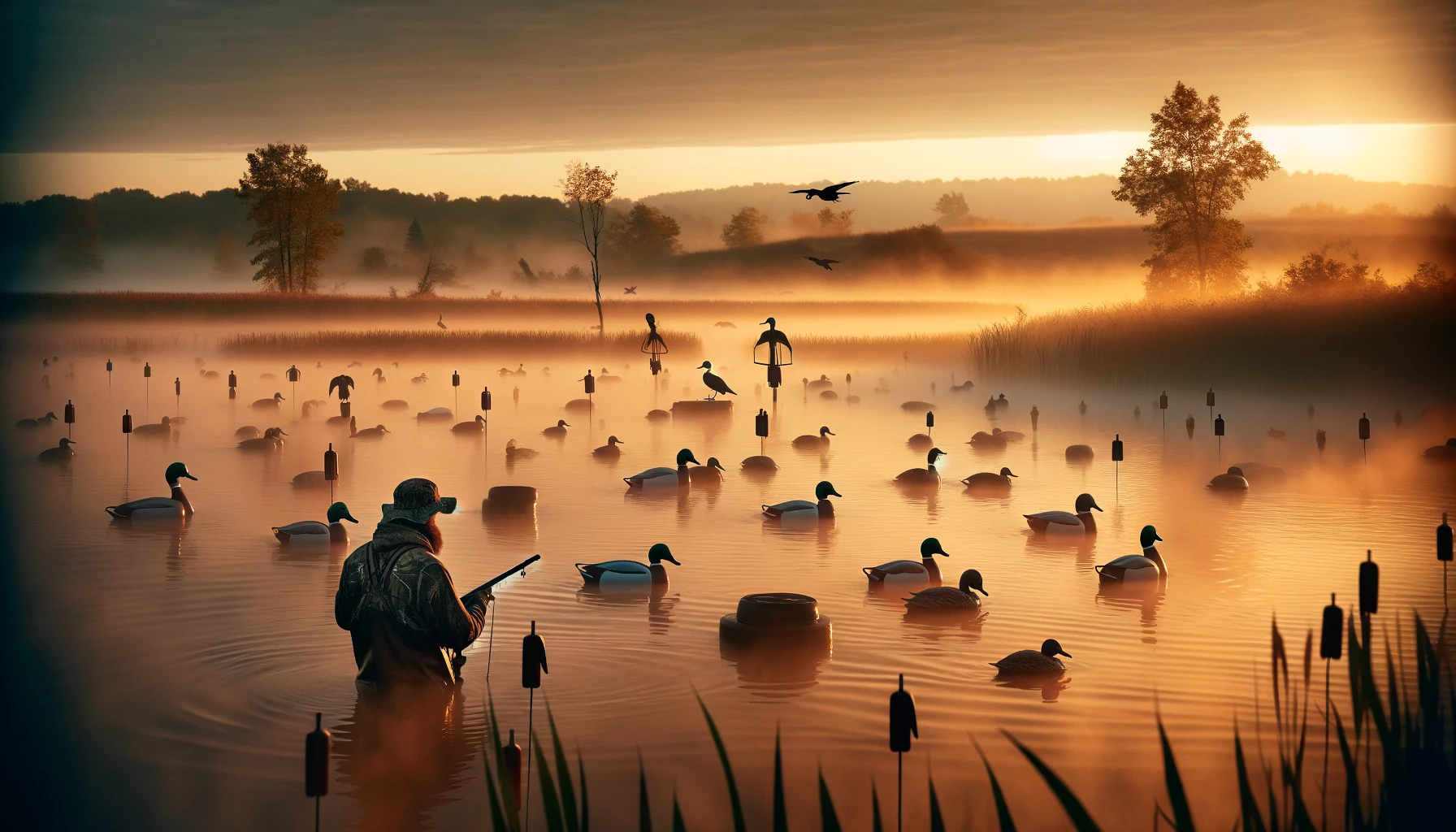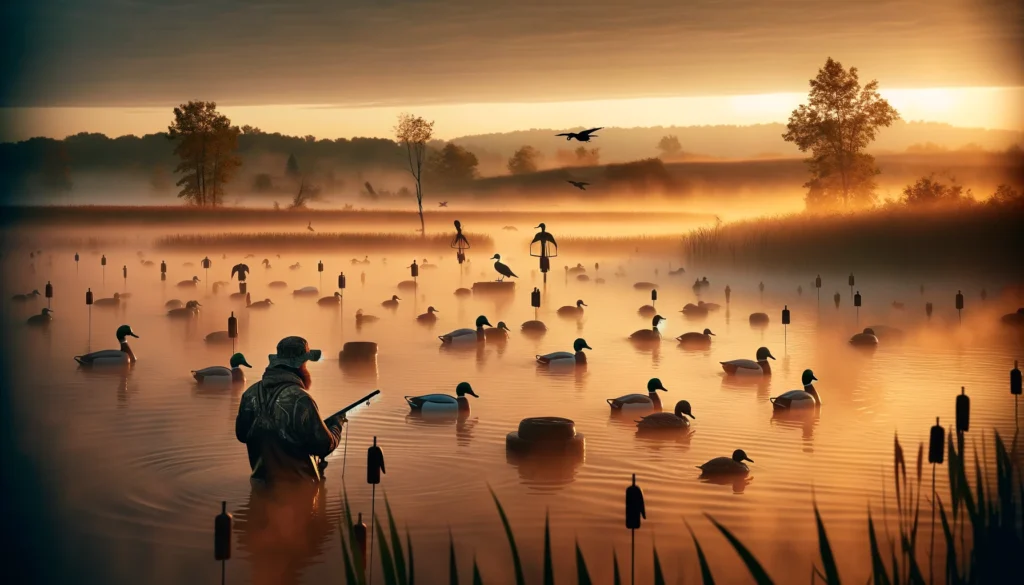The Ultimate Guide to Duck Decoy Setup: Strategies for Waterfowl Success


Table of Contents
Introduction
Duck hunting is an art form that combines skill, patience, and a deep understanding of avian behavior. At the heart of this pursuit lies the strategic placement of duck decoys—a technique that can significantly enhance your hunting success. This comprehensive guide delves into the intricacies of setting up duck decoys, offering both novice and seasoned hunters insights into crafting an irresistible spread.
Embarking on this journey, we’ll explore the principles behind effective decoy arrangements, the selection of gear, and advanced strategies to mimic natural duck behaviors, ensuring your next hunting trip is both productive and rewarding.
Chapter 1: Understanding Duck Behavior and Habitat
1.1 The Basics of Duck Ecology
To master decoy setup, one must first understand the quarry. Ducks are migratory birds that follow specific routes, known as flyways, across continents. Their behavior, including feeding, resting, and mating patterns, is influenced by seasonal changes, habitat types, and the presence of predators.
1.2 Identifying Key Habitats
Ducks frequent a variety of water bodies, from vast lakes and marshes to small ponds and rivers. Each species has preferences for certain environments—knowing these can help you choose the most effective decoy types and setups.
Chapter 2: Decoy Types and Their Uses
2.1 Standard Floaters
The backbone of any duck decoy spread, floaters are versatile and effective in various water conditions. We’ll explore different materials, species representations, and how to use them to simulate natural duck gatherings.
2.2 Full-Body Decoys and Shell Decoys
Ideal for field setups near water bodies or dry feeding areas, full-body and shell decoys add realism to your spread on land. Learn how to position these decoys to attract flying ducks looking for a place to rest or feed.
2.3 Motion Decoys
From spinning wing decoys to swimming and feeding simulators, motion decoys can be the key to breaking the wariness of late-season ducks. Discover the latest innovations in motion decoys and how to integrate them seamlessly into your spread.
Chapter 3: Crafting the Perfect Decoy Spread
3.1 The Art of Concealment
The effectiveness of your decoy spread is directly tied to its ability to blend into the natural environment. This section covers strategies for using natural vegetation and terrain features to conceal decoys, making them more appealing to cautious ducks.
3.2 Spread Configurations for Different Scenarios
Tailoring your decoy spread to match the day’s hunting conditions is crucial. We’ll break down several configurations, including the classic “J” and “U” shapes, and discuss how weather, wind direction, and duck species influence spread design.
3.3 The Role of Wind and Weather
Wind direction and speed can dramatically affect duck movement and behavior. Learn how to adjust your decoy spread in response to changing weather patterns to keep your setup attractive throughout the hunting day.
Chapter 4: Advanced Decoy Placement Techniques
4.1 Creating Landing Zones
An effective decoy spread invites ducks to land by providing clear, open areas within the setup. Detailed here are techniques for creating these landing zones to guide ducks into optimal shooting range.
4.2 Mimicking Natural Duck Behavior
A static decoy spread is a missed opportunity. This section delves into strategies for arranging decoys to mimic feeding, resting, and alert behaviors, making your spread irresistible to passing ducks.
4.3 Decoy Adjustment and Maintenance
Regular maintenance ensures your decoys remain effective throughout the season. Tips for cleaning, repairing, and periodically adjusting your spread based on observation and success rates are discussed to keep your setup fresh and appealing.
Conclusion
Setting up duck decoys is a dynamic challenge that requires flexibility, observation, and an ongoing willingness to learn from both successes and failures. By applying the strategies outlined in this guide, hunters can elevate their decoy setups, attracting more ducks and enhancing their hunting experiences.
The journey from novice to expert in duck decoy setup is both challenging and rewarding. With each hunting trip, you’ll gain insights and develop intuition, continually refining your approach to decoy placement. Remember, the ultimate goal is to enjoy the hunt, respect the wildlife, and share the tradition of waterfowl hunting with future generations.
Frequently Asked Questions (FAQs)
1. How many decoys do I need for a successful duck hunt?
- The number can vary widely depending on the location, species targeted, and time of season. Generally, a mix of 12-24 decoys can be effective for small to medium water bodies. For larger areas or highly competitive environments, more may be necessary to create a convincing spread.
2. Can I use the same decoy spread for different duck species?
- While a basic spread might attract various species, tailoring your decoy types and configurations to specific species based on their behaviors and preferences can significantly increase your success rates.
3. How important is decoy quality?
- High-quality decoys with realistic paint and durable materials can improve your spread’s effectiveness. They tend to offer better detail, more lifelike movement, and withstand harsh conditions, making them a worthy investment over time.
4. Do motion decoys really make a difference?
- Yes, motion decoys can add a critical element of realism to your spread, especially on days with little natural water movement. They mimic the live movements of ducks, making your spread more attractive and convincing.
5. How do I choose the best location for my decoy spread?
- The best locations are typically near natural food sources, along flight paths, or where ducks have been observed resting or feeding. Look for areas with clear visibility from the air, access to open water, and natural cover for concealing yourself and your equipment.







